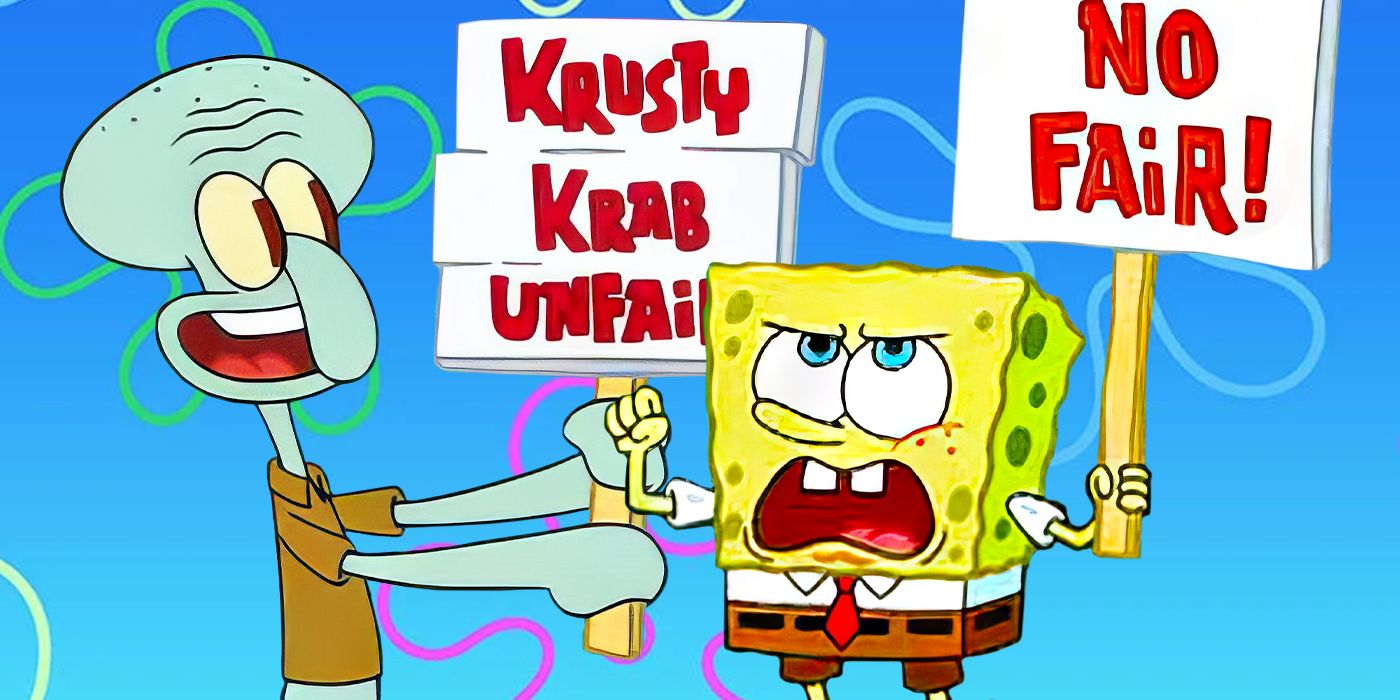In today’s economy, workers’ uprisings and the challenges they face are highlighted in the SpongeBob SquarePants episode “Squid on Strike.” This episode sheds light on the difficulties of convincing individuals to leave their comfortable situations in pursuit of a better future. While the strike is short-lived, it showcases the power that workers hold when they decide to disrupt a company due to mistreatment. Surprisingly, SpongeBob SquarePants and our discussions about labor in this country have more in common than we might think.
Stephen Hillenburg’s long-running animated series has ventured into the corporate landscape in episodes featuring SpongeBob’s boss, Mr. Krabs. “Squid on Strike,” written by Walt Dohrn, Paul Tibbitt, and Mark O’Hare, somewhat mirrors the labor disputes taking place in Hollywood, where workers are fighting against wealthy elite individuals who refuse to give back to the artists responsible for their fortunes. The episode centers around Squidward’s leadership as he leads a short strike with SpongeBob, showcasing the challenges faced by workers’ uprisings in today’s economy. However, this episode also reveals how workers’ solidarity can lead to success.
The strike in “Squid on Strike” is prompted by Mr. Krabs making changes to his workers’ paychecks after noticing a decline in profits. He replaces their paychecks with bills for petty disturbances, charging Squidward and SpongeBob for seemingly mundane activities. Squidward refuses to accept being charged extras for “goofing off” and convinces SpongeBob to join him in a strike for better working conditions, resulting in their termination. However, SpongeBob’s lack of understanding about striking becomes evident. He cries after being fired, struggles to protest by throwing his hat to the ground (a symbol of oppression), and misspells “unfair” as “funfair” while painting protest signs. SpongeBob eventually comes to understand Squidward’s impassioned speech about dismantling oppression, leading him to sabotage the Krusty Krab restaurant overnight. Though SpongeBob misinterprets Squidward’s words, his actions ultimately lead to their reinstatement but with the requirement to work indefinitely to pay for the damages.
While SpongeBob and Squidward strike for their rights, they face resistance and misunderstanding from the citizens of Bikini Bottom. When Squidward throws his hat on the ground in protest, he is issued a littering ticket by a police officer. During Squidward’s speech, the community seems disinterested until they realize that the strike has made them hungry, causing them to storm into the Krusty Krab. The lack of support from their peers demonstrates the challenges of convincing individuals to sacrifice their comforts for a better future. Even SpongeBob encounters a teenager willing to take his job without a second thought. Although SpongeBob momentarily realizes the severity of his situation when the teenager takes his job, he fully commits to the strike only after being inspired by Squidward’s passionate speech, despite not fully understanding the speech itself.
The difficulties faced by Squidward and SpongeBob are representative of the struggles workers face when trying to unite. The episode reflects the unfamiliarity of Bikini Bottom’s citizens with workers’ rights, mirroring the police’s indifference to Squidward’s actions. However, Squidward’s attempt to break the strike and beg for his job back leads to a surprise turn of events. Mr. Krabs acknowledges the impact of Squidward and SpongeBob’s absence on the Krusty Krab, as well as the negative consequences of hiring replacement labor. This realization prompts Mr. Krabs to give in to Squidward’s demands, albeit hesitantly. It is worth noting that Squidward and SpongeBob’s strike lasts only one day before their demands are met.
Despite its comical nature, “Squid on Strike” effectively portrays the language and means required for a successful strike. The characters picket, discuss their oppression by corporate figures, and aim to build solidarity within the community through “workers united.” The episode also highlights the negative aspects of striking, such as crossing picket lines and the mistreatment of workers. Though SpongeBob’s literal interpretation of Squidward’s words results in the destruction of the restaurant, it also emphasizes the power workers hold when they are mistreated.
Overall, “Squid on Strike” demonstrates the possibility of workers uniting and advocating for their rights against big business. The episode may not depict SpongeBob and Squidward as the perfect examples of unified workers, but it showcases the appropriate language and steps needed for workers to break free from the weight of corporate entities. And it’s important to note that “Squid on Strike” is not only a thought-provoking episode but also one of the best episodes from SpongeBob SquarePants’ golden era, making it a noteworthy example of the show’s brilliance.
Denial of responsibility! TechCodex is an automatic aggregator of the all world’s media. In each content, the hyperlink to the primary source is specified. All trademarks belong to their rightful owners, and all materials to their authors. For any complaint, please reach us at – [email protected]. We will take necessary action within 24 hours.
Khushi Patel is a science fiction author who lives in Austin, Texas. She has published three novels, and her work has been praised for its originality and imagination. Khushi is a graduate of Rice University, and she has worked as a software engineer. She is a member of the Science Fiction Writers of America, and her books have been nominated for several awards.


